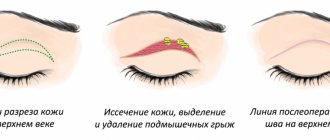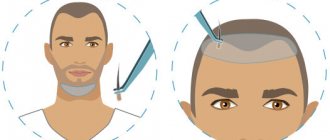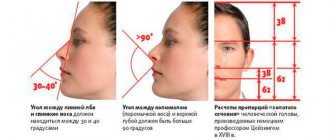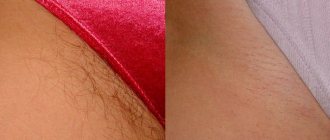Why does a bruise appear?
In medicine, any bruise is considered a hematoma. It occurs against the background of rupture of blood capillaries and is formed for one of the reasons:
- The presence of diseases of internal organs, problems with the circulatory system (leukemia, hepatic cirrhosis, von Willebrand disease, varicose veins, vasculitis).
- Mechanical impact on the body (bruise, blow, compression, injections).
Bruises under the eyes, which are popularly called bags, occur due to overwork of the body. It can be caused by insomnia, stress, severe physical and mental stress, and excessive drinking.
Bruises on the face
Even if a person hurts his forehead or the bridge of his nose when falling, a bruise will form under the eye. This is explained by the fact that when a bruise occurs, blood vessels rupture and bleeding begins under the skin. And since the tissue under the lower eyelid is loose, blood accumulates there. In this case, there are some possible solutions.
- If there is a bruise under the eye, then it is necessary to apply ice without waiting for swelling to begin. Just apply the ice pack to your cheek or under your lower eyelid, not your eye.
- If the bridge of the nose is damaged and blood is flowing from the nose, then you should try not to blow your nose (as air may get in, which will only increase the hematoma). A piece of bandage is inserted into the nostrils, and the use of cotton wool to stop bleeding is prohibited. You can moisten the turundas with a 3% solution of hydrogen peroxide, and then tightly pack the nostrils.
- If you experience vision problems or pulsation at the site of the injury, you should seek medical help.
How long does a black eye last? This is a common question. With treatment, it will take 5-7 days for regeneration; in the absence of treatment, the bruise may be noticeable for 2-3 weeks.
If you are interested in how to shorten the process of regeneration of soft tissues in case of a bruise, then it must be said that heparin-based ointments will help get rid of the hematoma faster; you can find out about them from your doctor. The frequency of use of the ointment directly determines how quickly the bruise goes away; in addition, physiotherapeutic procedures and warming may be required.
The mechanism of bruise formation
The causes of hematomas are related to the anatomy of the skin. It consists of three layers:
- Epidermis. This is a thin area that does not have blood vessels and performs a protective function. With a closed injury, it is not damaged.
- Dermis. Consists of connective tissue fibers. The capillaries located in the dermis play a special role in the appearance of bruises. Pain at the site of the injury is felt due to the presence of nerve endings in this layer.
- Hypodermis. Subcutaneous fat is located deeper than the other layers. It contains small vessels. This is where bruises form, since adipose tissue is much softer than connective tissue.
The severity of damage cannot be assessed by the area of the hematoma. A huge bruise may not affect the lower layers of the skin and may not damage the muscles.
Other features of the body play a special role in the formation of hematomas:
- blood composition;
- permeability of vascular walls;
- thickness of adipose tissue;
- structure of blood vessels.
The older a person is, the more often he or she develops hematomas. A child may have no trace left after a blow, while an old person will have a huge bruise due to a similar injury. This is due to the weakening of blood vessels, loss of elasticity of the walls and impaired circulation in them.
Color change
The size and color of the bruise depend on several factors:
- location relative to the vessels (pulsating hematoma occurs as a result of disruption of a large artery, non-pulsating hematoma occurs due to damage to small capillaries);
- the amount of accumulated blood;
- duration of injury;
- force of mechanical action (the higher it is, the deeper the hemorrhage occurred in the tissue).
The appearance and resorption of a hematoma occurs in several stages, which are accompanied by a change in the shade of the bruise:
- Red-purple. The red color is a consequence of damage in the first hours after the injury. This shade is due to the penetration of red blood cells into the skin tissue, which contain oxyhemoglobin of the corresponding color. During these hours, a person feels the greatest pain, and edema forms in the form of swelling.
- Blue or purple. The next day, the bruise acquires this color because the process of oxidation of oxyhemoglobin in the tissues occurs. Resorption has not yet begun, but the swelling is gradually subsiding.
- Green. The hematoma acquires this shade 5-6 days after injury. This occurs due to the biochemical transformation of hemoglobin, which enters the tissue from red blood cells. Biliverdin is formed, which has a greenish tint. Pain and swelling will disappear by this time.
- Yellow. In the final stage, the bruise turns yellow because biliverdin is converted to bilirubin. Over time, the hematoma will disappear under the influence of macrophages, which absorb dead cells. The yellow spot dissolves and leaves no trace.
Similar phases are observed when a significant volume of blood is released. If ice was applied immediately after the blow, the bruise will not look as noticeable.
Bruise and its severity
The gradation of severity of such damage depends on the condition of the tissues and the course of the process itself. In medicine, the following degrees of severity are distinguished:
- First. In this case, the hematoma is mild and appears within the first 24 hours after the damage has been caused. The soft tissues are not particularly affected, resulting in mild pain upon palpation. If you look at the bruise, there is no significant swelling, and the damaged area retains its functionality.
- Second. This is already average severity. In this case, hemorrhage appears after 3-5 hours. The injury affects nearby tissues and muscles, which is why the victim may feel pain without pressing on the sore spot, and swelling can be visible to the naked eye. There is mild dysfunction of the damaged area: for example, if an arm or leg is injured, it is extremely difficult to move them freely.
- The third degree is the most severe. The bruise appears literally in the first hour after the injury. Not only the upper layers of the skin suffer, but also the muscles, which causes severe pain. Therefore, there is severe dysfunction. The damaged area swells greatly.
If no complications are observed, the healing process of the resulting hematomas must go through three main stages:
- At the first stage, the bruise looks like a red swelling. As for the size and accompanying pain, the degree of damage plays a major role here. After 2-3 days, the bright red tint turns purple, or a purple bruise appears.
- At the second stage, the hematoma changes color from dark to yellow. This change begins from the edges of the hemorrhage and gradually reaches the center. If the area of damage is large, then small yellow bruises appear at the edges, and the skin between them acquires a normal color. The pain becomes less severe.
- The last (final) stage is observed 1-2 weeks after the injury. The bruise becomes greenish in color, and you should not be alarmed if it slightly changes its location, going down. The fact is that gore also has weight, and gravity acts on it. Therefore, the bruise “slides off.” The swelling decreases, the pain goes away, and the skin becomes normal in color.
I would like to note the fact that the area of damage should not be assessed as the severity of the injury. That is, a bruise can be the size of half an arm, but the hemorrhage affected only the upper layers of the skin, and the muscles remained unharmed. It is also worth saying that these stages and deadlines are approximate. If the hematoma has a complication, the situation may turn out differently.
Home treatments
If the bruise is caused by a blow, you should apply something cold to the sore spot and hold it there throughout the day. This will help reduce the size of the hematoma and speed up its healing. After 2 days, warm compresses are applied. If, apart from the external manifestation of bruising and swelling, there are no other alarming signs, you can do without going to the doctor.
Today, the pharmaceutical market offers a huge number of products to get rid of bruises. These include:
- Lyoton;
- Troxevasin;
- Bruise-off;
- Heparin ointment;
- Badyaga;
- Voltaren;
- Finalgon;
- Hepatrombin.
These ointments have wound healing, regenerating and analgesic effects. It is advisable to use them 7-8 hours after the impact. If you apply them immediately, they will increase swelling and provoke the appearance of a more pronounced hematoma.
As non-traditional methods of treatment, lotions with aloe, compresses with tincture of calendula and golden mustache, cabbage or potatoes, and garlic infusion are suitable. Before using traditional recipes and medications, you should make sure there are no contraindications.
When to see a doctor
There are a number of cases in which timely medical assistance is necessary:
- A huge and painful bruise on the arms or legs. There is a risk of broken bones or cracks in them.
- Increased temperature, severe throbbing pain, increased swelling. These symptoms may indicate an infection.
- The appearance of a hematoma for no reason. In this case there were no blows or bruises.
- Pulsating hematoma. He speaks of a rupture of a large artery and requires stopping the blood.
Sometimes surgery is required to remove a large bruise. The contents of the hematoma are removed using a puncture needle and syringe.
You should also consult a specialist when all known methods have failed and the bruise does not change color. Individual therapy is necessary in the case of blood clotting disorders, pathologies of the vascular walls, and diseases of the hematopoietic system. Therefore, you should not start self-treatment without consulting a doctor.
In most cases, bruises appear after blows, injuries, or bruises.
Rarely have a pathological etiology or are a cosmetic defect. Special creams and ointments will help eliminate bruises.
Healing depends on the extent of the damage. If such manifestations are a consequence of an unhealthy lifestyle, then symptomatic treatment will not be effective.
What to do?
The severity of the injury depends on what the victim does after the injury. An effective method that allows you to mitigate the consequences of injury is an ice compress, which prevents the development of hematoma, the growth of swelling slows down, and fewer blood cells are released from the capillaries. If it is not possible to use ice, you can replace it with some other cold object.
Herbal compresses will help mitigate the consequences; medicinal herbs include St. John's wort, plantain and others. A compress based on onion juice can prevent the development of hematoma. Do not forget about one factor - any compress should be cold. Warm not only will not have an effect, but also provokes the development of a tumor.
Causes of a bruise under the eye
It is important to consider that a black eye under the eye, which is not associated with pathological processes, may appear for the following reasons:
- abuse of drugs, alcohol, smoking;
- intoxication of the body;
- chronic fatigue and poor sleep;
- incorrect makeup;
- use of low-quality skin care products;
- genetic predisposition;
- violation of the structure of blood vessels;
- the location of the vessels is too close to the surface of the skin.
In some people, a hematoma may occur with a mild bruise. The healing process takes a long time. This is affected by the specific type of skin. Many diseases can be accompanied by such signs. In this case, bruises appear under both eyes. This is mainly due to disruption of the digestive system. This is often a sign of helminthiasis. Worms cause intoxication and have many characteristic symptoms.
How to disguise a hematoma?
Not all injured people are able to take time off from work or avoid going out to public places. Therefore, a bruise on the face often becomes a cause of acute distress and discomfort. In these cases, a few simple steps to mask the hematoma and relieve swelling can help.
Salt compress
This is the fastest way to eliminate post-traumatic swelling, but it is very harmful to the skin. Therefore, it is used only in extreme cases, when the appearance of the face needs to be put in order in a short time.
To prepare the product, salt (3 tbsp) is dissolved in warm boiled water (1 l). Dip a gauze cloth into the solution for 5 minutes so that it becomes saturated with salt crystals. The compress is applied to the bruise for 20 minutes, the skin is washed with warm water.
Concealers
These concealers are designed to hide skin imperfections. The main thing is to choose the right concealer color:
- with a fresh blue-purple bruise - orange;
- for green hematoma - yellow;
- with a yellow bruise - purple, lavender.
It is better to mask large hematomas with a coverstick, and small bruises can be treated well with creams or pencils.
Many people are accustomed to treating facial bruises as a minor injury. Often, treatment comes down to applying cold and taking painkillers. The face is part of the craniofacial skeleton, inextricably linked with the brain, respiratory and hearing organs. Therefore, it is important to be attentive to facial injuries and bruises, including minor ones.
Symptoms
The first symptom of damage is pain.
It all depends on the location of the injury. Unpleasant sensations can radiate to the head, face, nose. Often accompanied by headaches, discomfort, and burning. Heavy impacts can cause a concussion. In this case, the following symptoms occur: nausea, dizziness. Rarely, partial or complete memory loss may occur.
It is worth considering that a blow to the bridge of the nose is always accompanied by bleeding. The injured person should know that blowing blood is prohibited. This can cause a lot of swelling. Doctors recommend using cotton or gauze swabs in such cases. They are placed in each nostril. It is important to understand that cotton fibers can remain on the mucous membrane and cause the formation of pus. Therefore, it is better to make tampons from bandage or gauze.
After the pain syndrome, redness appears. Change in skin color is a characteristic sign. It occurs within several hours after a blow or injury. After this, the color of the damaged skin gradually changes. Within 24 hours, the lesion can spread over a large area.
Heavy impacts lead to decreased visual acuity. Swelling causes difficulty closing the eyelids. It may be difficult for the affected person to close his eyes. This often causes pain.
How long does it take for a black eye to appear after a blow?
After a blow, the injured person initially experiences severe pain. Then swelling appears. It is important to consider that the extent of the damage initially causes only redness. Over the course of a day, the damaged area of skin begins to darken. The area of damage may double in size. This occurs due to internal bleeding.
In addition, additional symptoms may be observed: decreased visual acuity, headaches of various types. Swelling prevents you from fully opening or closing your eyes. Severe injuries can cause bleeding from the ears. In this case, you will need to urgently consult a doctor.
A bruise is not a trifle: which hematomas are life-threatening
However, if the color of the skin remains unnatural for a long time, swelling does not go away and you experience pain, you should urgently consult a specialist.
Some people develop bruises even with a light blow, others are more permanent in nature, and they only develop bruises as a result of strong blows, jolts or bruises.
“A bruise is a subcutaneous hemorrhage without blood coming out,” explains Peter Walger, head of the department of intensive care medicine and infectious diseases at the Bonn clinic.
“A bruise occurs when tissue is injured and subcutaneous microvessels are ruptured,” adds Martin Hall, professor of physiology from Munich.
After three weeks the bruise should go away
Bruises appear more often in children, who often fall and hurt themselves while playing on the playground or in kindergarten, as well as in older people, partly due to decreased elasticity of blood vessels. If blood vessels are damaged inside the body, blood may pool in the subcutaneous tissue or accumulate in body cavities.
When blood coagulates, the color of the hematoma changes to dark blue, later becomes even darker, and then becomes yellow-green. After about two weeks, minor bruising disappears. “As a rule, it takes two to three weeks for the blood cells to be destroyed,” says Professor Rainer Hartenstein.
Unreasonable bruises are a sign of disease
People who take blood thinners or anticoagulants are especially prone to the formation of hematomas. Also, patients with diseases that impair blood clotting experience frequent spontaneous bruising.
For both of these groups, bruising poses a serious risk and requires timely medical evaluation and, if necessary, appropriate action.
In general, sudden bruises are cause for concern.
A seemingly harmless bruise could be a side effect of drugs that interfere with blood clotting, a consequence of some disease or even malignant neoplasms.
If you have a bleeding disorder, bruises appear more often
After severe falls or blows, bruises can occur as a result of broken bones or torn ligaments.
In both cases, victims, as a rule, experience severe pain, impaired motor function, and they have pronounced swelling of the corresponding part of the body.
If you suspect a fracture or rupture, consult a doctor. Otherwise, the risk of complications and secondary damage increases.
In hemophilia, a bleeding disorder causes bruising.
Even people with the most common birth defects with an increased tendency to bleed, such as von Willebrand disease, suffer from a bleeding disorder.
In addition, there are many other diseases, for example, the liver or the hematopoietic system, which are characterized by the formation of hematomas.
Medicines as a cause of hematomas
Some medications and their active ingredients promote bruising, such as acetylsalicylic acid or coumarin derivatives, as they affect blood clotting.
Many people do not know that taking aspirin and certain pain medications at the same time affects platelet function for several days and therefore inhibits blood clotting.
Hematomas are also possible due to cortisone, which disrupts the structure of the skin.
When to see a doctor?
Medical help should be sought in cases where hematomas are accompanied by symptoms such as severe swelling, pain, poor circulation, dizziness, limited body functions, and fever. You should be wary if the victim complains of pain in the abdomen, chest or head.
Hematomas are not always visible here because bleeding can occur inside the body and this is life-threatening. Bleeding inside the abdominal cavity is characterized by abdominal pain and poor circulation.
Particularly dangerous brain hemorrhages are often associated with headaches and neurological disorders such as paralysis or loss of consciousness.
First aid
It is important to consider that timely provision of assistance ensures a favorable result. After a blow or bruise, you need to apply cold to the damaged area. For this, ice is suitable, which must be wrapped in a towel. You can also apply a cold compress. The cold should be kept for 15 minutes, but no more. In this case, you need to pause periodically to avoid hypothermia.
Folk remedies must be used with extreme caution. Bee venom is popular. But it is forbidden to take it to eliminate bruises. The following medications are often used: Heparin ointment, “Bruise off”. These are products that are applied to the damaged eyelid or skin around the eyes.
How to disguise a bruise
To make a blanche, a bruise on the cheek, or a hematoma on the neck less noticeable, the consequences of the bruises must be properly disguised using decorative cosmetics.
Rules for masking hematomas:
- If there is edema and swelling, you need to apply cold before applying cosmetics.
- Apply a thin layer of concealer to the injury site - it should be easily pressed into the skin with your fingers or a sponge.
- To visually discolor a hematoma, you need to choose the right concealer color. A green product will help hide blue discoloration; yellow is better for lubricating red bruises. If the bruise heals, then its yellowed edges should be smeared with a blue or pale purple concealer.
- Even out your skin tone using a makeup base; apply it all over your face so that there is no noticeable difference in color.
- Apply translucent powder with a brush.
To lighten a bruise, you need to anoint it with toothpaste overnight - you should choose products without abrasive particles and dyes.
Cosmetics will help disguise dark circles under the eyes
How many days does a black eye last after a blow?
The presence of a hematoma at the healing stage is accompanied by a change in color. These signs can help you understand when a blow or injury occurred. The shade changes depending on the processes that occur in damaged tissues. The appearance and development of a bruise can be divided into several stages. They develop over several days. Completely disappears within 7-10 days. It depends on the extent of the lesion and timely treatment.
If you do not use medications, healing will proceed as follows:
- Redness appears within an hour;
- After 6 hours the color may turn purple, blue;
- After a day, the outline becomes brown with a green tint;
- Over the course of five days, the bruise will be blue in color and gradually turn yellow;
- After 7 days, the damaged area is significantly reduced in size;
- After two weeks, a yellow spot remains at the site of the bruise.
The bruise fades depending on the degree of damage and size.
Stages of bruise by day (photos for each stage)
The impact causes damage to blood vessels. Bleeding occurs under the skin, so it changes color depending on the severity of the injury.
First stage. The blood thickens and coagulates after the blow received. It begins to darken due to the processes that occur in the affected area. The skin takes on a blue, purple tint. This can be noticed within 24 hours after the impact. In this photo you can clearly see what the bruise will look like on the first day.
Second stage. After a few days, leukocytes accumulate in the damaged area. They lead to the destruction of red blood cells in hemoglobin. The last component begins to produce a green pigment, so the bruise takes on this shade around the 5th day. You can see this change in the photo.
Third stage. After these processes, bilirubin begins to be produced in the affected area. This component has a characteristic yellow color. That's why the bruise takes on this color.
The hematoma gradually disappears every day. After 9-10 days, the skin becomes natural color, and not a trace remains of the bruise.
Stages of hematoma formation and measures of influence
Hematoma goes through 3 stages.
First stage
In the first stage, blood flowing from the vessels fills the space under the skin, seeping into the tissue, and as red blood cells break down, hemoglobin changes color to blue. At this stage, the hematoma needs to be cooled to reduce bruising. To do this, you can apply ice wrapped in a towel or any cold object. Cooling has a constricting effect on the vessels, from which less blood flows. It is advisable to apply the cold immediately and hold it for about 10 minutes, and then repeat the procedure every 2 hours. It is not recommended to take a hot shower or visit a sauna during this period.
Second stage
The second stage is characterized by changes manifested by a decrease in swelling, and the hemorrhage itself becomes blue, with a yellow tint around the edges.
If the size is large, yellow spots may appear on the surface of the subcutaneous hematoma. This stage occurs 2–3 days after its appearance. Compresses that help the blood clot dissolve using heparin ointment give good results.
Heat in the form of a compress increases blood flow, which leads to vasodilation and the removal of dead blood and lymph cells. For a warm compress, you can use a linen bag, into which you should pour sand or salt, and then warm it up and apply it for 10 minutes. It will be useful to use a heating pad on the injury site.
Third stage
The third stage occurs after 3–5 days. The hematoma may go down a little and become green. At this stage, the use of warm compresses continues. Over time, the swelling and compaction disappear, and the epidermis acquires its normal color.
Any subcutaneous hematoma can become complicated; inflammation leads to the formation of an abscess. You need to tell your doctor about the complication, and he will take action or give advice on how to get out of the situation as quickly as possible.
Following the doctor's instructions will allow you to completely get rid of the hematoma in 5 or 6 days, which will not leave any traces behind.
Preparations for rapid resorption of a black eye after a blow
It is important to consider that a bruise caused by a blow can only be cured with special ointments and gels. The following means are mainly used:
- Lyoton. The ointment helps normalize blood flow in the affected area and accelerates tissue restoration. Helps get rid of bruises of varying severity. Apply to the damaged area 2-3 times a day for a week.
- Lyoton forte. The ointment is mainly used for varicose veins. But it eliminates swelling well and produces a resolving effect, so in severe cases it is recommended for bruises under the eyes. Apply to the affected skin 2 times a day until the hematoma disappears.
- Bruise off. This is a popular remedy that is found in almost every home medicine cabinet. The main substance in this product is leech extract. This component has an anti-inflammatory effect and improves local blood flow. Helps accelerate the regeneration of damaged tissues. It is worth noting that the ointment should be applied immediately after a blow or injury. This will help get rid of the bruise faster. Can be applied to skin 5 times a day.
- Badyaga. This drug contains natural ingredients. To make the bruise disappear, apply the ointment 3 times a day. Has an antibacterial effect, normalizes local blood circulation.
- Heparin ointment. A well-known remedy that is recommended to be taken for bruises of varying severity. After the impact, the ointment is applied every hour during the day. When it passes, use is reduced to every 2-3 hours.
Medicines do not require a doctor's prescription.
They can be used independently at home. You should consult a doctor if there is bleeding, a cut, or when the blow was severe and led to a head injury. In this case, treatment will depend on the severity of the damage. If the bruise lasts more than two weeks, you should also consult a specialist.
How to quickly remove a bruise: only scientific methods
A bruise is one of the types of hematomas. But if a hematoma in general is an internal hemorrhage that occurs due to damage to blood vessels and can be quite extensive and serious, then bruises are relatively harmless damage to the smallest subcutaneous vessels - capillaries.
When injured, the capillaries break, burst and blood flows out of them. The more leaked, the larger the bruise.
How quickly do bruises go away?
On average, it takes our body two to three weeks to get rid of a bruise. All this time, the spilled blood is absorbed by the surrounding tissues.
Moreover, the more blood there is under the skin, the more time it will take the body to resolve the hematoma. Fortunately, the process can be sped up.
But for this it is important to know at what stage of healing the bruise is.
What will help two days after a bruise should absolutely not be done the first.
How to remove a bruise if less than a day has passed since the injury
The bruise has not yet fully formed. The bruise site was slightly swollen and turned red-pink. The color lasts from several hours to a day.
The main task at this time is to prevent the bruise from growing.
Relax!
Try to limit movements, especially those that involve the affected area of the body. The more movement, the stronger the blood flow and the more extensive the filling hematoma.
Apply a cold compress
Immediately after the injury! The faster, the smaller the bruise will be. Under the influence of cold, blood flow slows down, which means less flows into the subcutaneous tissues. In addition, a cold compress reduces pain.
As a compress, you can use an ice pack or, for example, frozen vegetables. Wrap it in a thin cloth or towel and apply it to the injured area for 10 minutes. The procedure can be repeated after a 20-minute break.
On the first day, under no circumstances should you warm up the bruised area, much less massage it. This will increase blood flow and the bruise will grow.
Apply pharmaceutical cream or gel for bruises without a warming effect
Such drugs have anti-edematous and anti-inflammatory effects. Look for dimethyl sulfoxide, heparin and dexpanthenol in the list of active ingredients.
Try to keep the injured area above heart level
Naturally, if possible. For example, if your leg is injured, lie down on the sofa and place your feet on a bolster or armrest. Gravity will force the blood to drain away from the bruise, which means the bruise will be smaller.
If the pain is severe, take pain medication
But not aspirin or ibuprofen. They thin the blood and can lead to an increase in the size of the hematoma.
How to remove a bruise if more than a day has passed since the injury
As a rule, after 24 hours the bruise has already formed. The blood at the site of the injury has darkened and appears through the skin with a blue, purple or (if several days have passed since the injury) a greenish tint.
Now the main task is to speed up the resorption of the hematoma. The easiest way to achieve this is with heat.
Warm up
Warm compresses (you can apply a heating pad or a cloth moistened with warm water to the bruise), massages, as well as creams with a warming effect - containing badyagu, capsaicin (pepper alkaloid) and bee and snake venoms - have proven themselves well.
To speed up recovery, you can also go to a hot bath. Unless, of course, you have contraindications to this.
If it still hurts, take a painkiller with a decongestant effect.
For example, aspirin and ibuprofen (now possible). They are indicated if the bruise appears swollen. Of course, strictly follow the instructions for frequency and dosage!
Use creams or compresses with herbal extracts and vitamins
- An ointment or gel based on arnica extract reduces swelling and accelerates regeneration.
- Cream with vitamin K improves blood clotting and helps restore damaged capillaries and blood vessels.
- Aloe gel reduces pain and reduces inflammation. Gels with the highest possible (up to 99%) content of pure aloe juice work best.
- Vitamin C cream has anti-inflammatory properties and improves wound healing.
- Products based on pineapple extract, thanks to the plant enzyme bromelain contained in this fruit, have an anti-inflammatory effect and accelerate the disappearance of bruises. Treating yourself to some pineapple won't hurt either.
To restore, it is not necessary to use pharmaceutical products.
For example, a compress of finely chopped onions (chopped, wrapped in gauze, slightly pressed so that the onion releases its juice, applied to the bruised area) will also have a positive effect due to its vitamin C content.
Disguise
A few days after the injury, when the color has faded, the bruise can be hidden with foundation. Choose a product with a yellowish undertone.
When to show a bruise to a doctor
Bruising does not always go away on its own. In addition, sometimes they can be symptoms of not the most pleasant diseases. Be sure to consult a therapist as soon as possible if the bruise:
- It does not disappear, although more than two weeks have passed since the injury.
- It seems hard to the touch.
- Begins to increase in size and/or becomes more painful.
- Adds pain to the movements of the joint next to which it is located.
- It is located next to the eye and, as you think, impairs vision.
- Appeared seemingly for no reason. And not only that: you regularly notice more and more bruises on your skin of an origin that is not entirely clear to you.
- It begins to show signs of infection: some discharge from the skin appears in the damaged area, the temperature rises.
All this may indicate that the hemorrhage is much deeper and more extensive than you thought, and for some reason the body tissues cannot cope with so much blood. In this case, to get rid of the hematoma, you will need the help of a doctor.
Diseases of internal organs and physiological fragility of blood vessels are also possible. These situations also require the attention of a specialist.
Source: https://Lifehacker.ru/kak-ubrat-sinyak/
Color change
The reduction of the hematoma is accompanied by changes in the shade of the skin in the damaged area. Flowering stages may vary depending on how severe the damage is.
At the first stage, the bruise is dark blue in color. If the impact was too strong, the shade may be almost black. The skin gets this color because of hemoglobin. The more substance leaves the vessels, the more hemoglobin will be released in the blood, and the darker the bruise will be. The color also depends on the timeliness of the measures taken: if immediately after the blow a cold compress is applied to the damaged area of the skin, the hematoma will turn out lighter and will be smaller in size.
In the second stage, the blue color remains in the center of the bruise. It turns yellow around the edges. If the bruise is large, yellowness may appear in spots over the entire surface. Heparin compresses and heat help speed up the healing process.
The last stage is characterized by yellowing of the hemorrhage. Sometimes the shade is closer to green. After some time, the bruise will completely resolve and the skin tone will return to normal.











